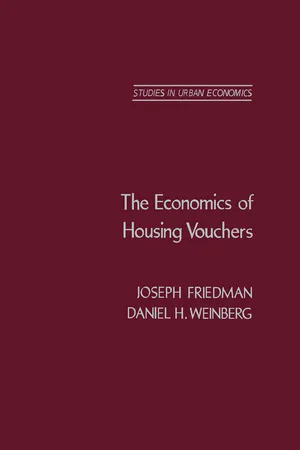
- 236 pages
- English
- PDF
- Only available on web
The Economics of Housing Vouchers
About This Book
The Economics of Housing Vouchers is a seven-chapter text that examines the housing choices of low-income families in two metropolitan areas, namely, Phoenix and Pittsburgh. Some of these households are offered a novel kind of housing subsidy, including a housing allowance or housing voucher, in an experimental framework designed to test this approach to demand-side housing assistance. Chapter 1 presents an overview of U.S. housing programs and the dimensions of the U.S. housing problem. Chapter 2 provides a simple microeconomic model that conceptualizes household behavior, as well as a summary of some of the extant evidence on housing demand. This chapter also estimates the housing demand models for the low-income population in the Demand Experiment, using housing expenditures to measure housing. Chapter 3 applies a hedonic index of housing services that abstracts from particular characteristics of the household or landlord that may affect rent and attempts to measure housing in a more objective manner. Chapter 4 describes a model of household behavior that leads to the methodology for estimating experimental effects. Chapter 5 repeats the analysis for Minimum Rent households, while Chapter 6 examines the effect of both kinds of Housing Gap allowance payment on the consumption of housing services. Lastly, Chapter 7 focuses on the implications of the experimental findings for housing policy. This chapter compares a housing allowance strategy with two other approaches, namely, a pure income-transfer approach and a construction-oriented approach. This book is of value to workers in housing policy, including economists, regional and other social scientists in academia, housing analysts, the Congress, housing lobby groups, and state and local government housing officials.
Frequently asked questions
Information
Table of contents
- Front Cover
- The Economics of Housing Vouchers
- Copyright Page
- Table of Contents
- Dedication
- Preface
- Acknowledgments
- Chapter 1. Introduction
- Chapter 2. The Demand for Rental Housing
- Chapter 3. The Demand for Housing Services
- Chapter 4. The Effect of Minimum Standards Housing Allowances on Housing Consumption
- Chapter 5. The Effect of Minimum Rent Housing Allowances on Housing Consumption
- Chapter 6. The Effect of Housing Gap Allowances on the Consumption of Housing Services
- Chapter 7. Policy Implications
- APPENDIX I: Design of the Demand Experiment
- APPENDIX II: Selection Bias in Price Elasticity Estimates
- APPENDIX III: The Methodology for Estimating the Experimental Effects on Housing Gap Households
- APPENDIX IV: Additional Tables
- APPENDIX V: Intraurban Residential Mobility: The Role of Transactions Costs, Market Imperfections, and Household Disequilibrium
- References
- Index